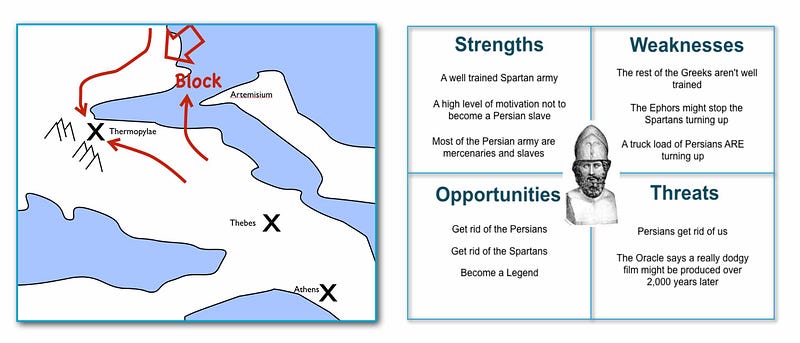- Towards Burja Mapping
- Why Map Power?
- Foundations of Burja Mapping
- On the Use and Abuse of SWOT Diagrams
- Mapping Moneyball
- Mapping Resources of Power
In my previous posts, I’ve discussed Burja Maps as a complement to Wardley Maps and other tools for assessing the strategic landscape. Juxtaposing different kinds of analyses (or the same tool used in multiple contexts) allows for a more thorough and accurate assessment of the landscape. In this post, I’ll talk about one tool that is surprisingly useful in combination with Burja Maps: the lowly SWOT diagram.
Early in Simon’s book, he has a rather amusing example of the misuse of SWOT diagrams: what if Themistocles had used a SWOT diagram rather than a map in searching for a way to thwart the Persians?

Until recently, I hadn’t seen the use of SWOT diagrams. I never quite understood what opportunities or threats were, or how they were different from strengths and weaknesses. Accordingly, it was easy to laugh at Simon’s mocking of SWOT diagrams early in the book.
Now, however, I can see that Simon was using SWOT diagrams as a sort of straw diagram. He does say later in the book that they have their uses:
“SWOT? But isn’t SWOT the curse of simplistic management? Yes, but it also has its uses particularly if we understand the landscape. The problem with SWOT isn’t that it is useless but instead we apply it to landscapes we don’t understand.” — Simon Wardley
But which landscape? In the context of an empire and a domain of competition, they suddenly make a lot of sense, and have incredible value. Here, a SWOT diagram can help us orient more effectively towards the players in the relevant empire.
“Have no fear for I have created a SWOT diagram!”
While empires are fractal, they are not infinite. They have a sort of “bottom” layer, composed of the raw stuff of any empire: people. There are people at every power class, from High to Low; and while certain people may have more officially sanctioned power than others, power can be redistributed in the blink of an eye.
So while a given person might be at a different power class than another, SWOT diagrams can help us to see that people have the same basic shape. In particular, that they have strengths and weaknesses, goals and obstacles. This is how I’ve found it useful to think about the O and T in SWOT diagrams: not as Opportunities and Threats, but as Objectives and Traps:
- Objectives: What is this person’s personal, local goals and vision — which are not unrelated to but not the same as the shared purpose in the broader empire? How can you help them achieve their goals- or prevent them?
- Traps: With allies, what problems might they and your weaknesses cause together? With opponents, what traps might they actively lay for you?
For example, here is a SWOT diagram for a hypothetical (fabricated) fundraiser in a non-profit organization like the one I work for. No monastics were harmed in the making of this SWOT diagram.

A sample SWOT diagram for a hypothetical player in a Burja Map
One of the first things that making SWOT diagrams for the people in my networks has done for me is to give me more compassion for myself and others. Everyone has weaknesses — even the “High” people! Joe’s tendency to be impulsive and aloof is just his thing; I have my thing; he’s working on his thing, I’m working on my thing. It’s all good!
Another thing that I’ve noticed is that fog of war about the goals of others — and, even more troublingly, your own goals — is the default. In a perfect world, managers and their reports would be in constant communication about their respective goals. Short of that, simply communicating your goals to others, and asking for the goals of your allies, can make it more likely that you and your allies will accomplish your goals. It will also make it much, much easier to make allies in difficult situations.
Objectives and traps lend themselves to straightforward gameplay. If you can, helping people achieve their goals will bring you allies. If you know someone is an obstacle or an enemy, try to consider what traps they might lay for you (intentionally or unintentionally) and prepare for those ahead of time.
Finally, you can use SWOT diagrams to map any aspect of any empire: the empire as a whole, a sub-empire within it, or a single person or resource. In this post, I’ve mostly discussed making SWOT diagrams of people, but it should be straightforward to apply this model to any scope of any empire, e.g. the overall team or organization you find yourself in.
Subscribe to my newsletter, my YouTube channel, or follow me on Twitter to get updates on my new blog posts and current projects. You can also support my work and writing on Patreon.
